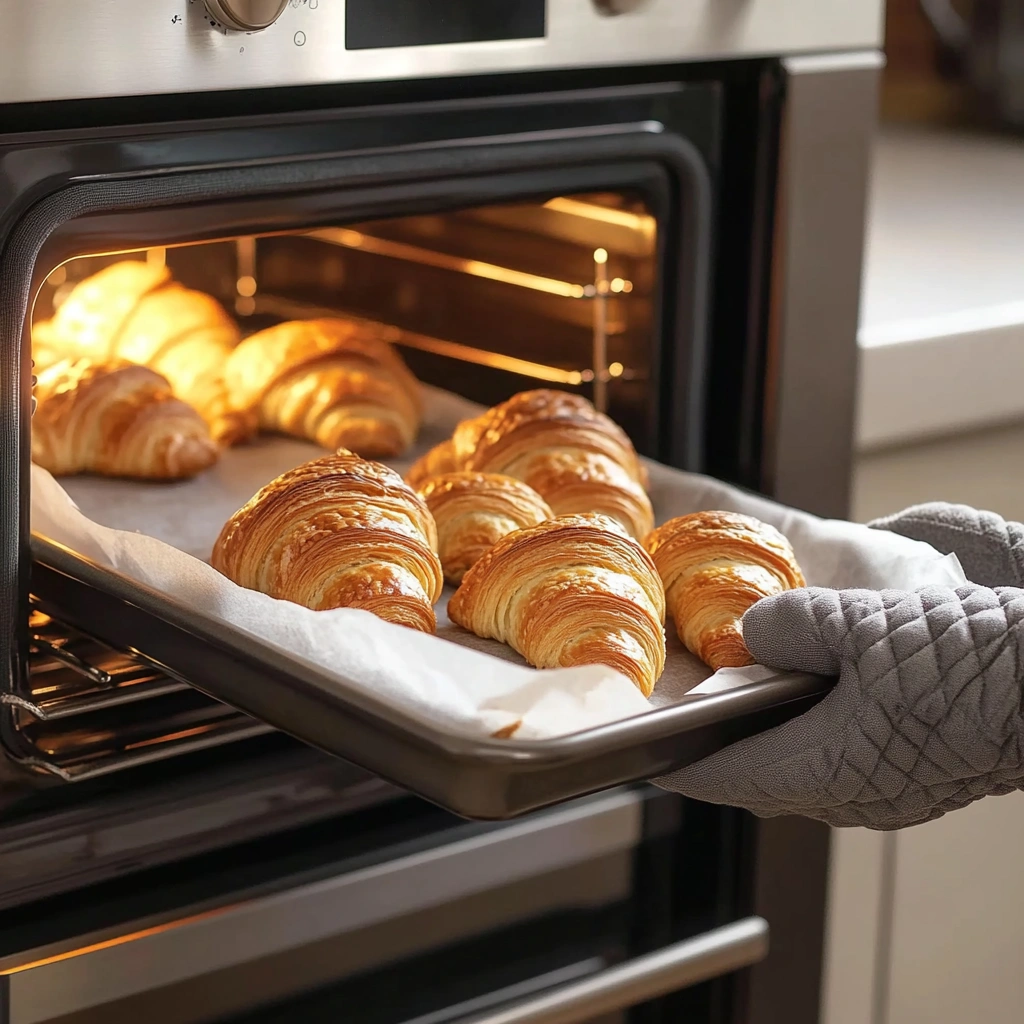Ah, croissants—those buttery, flaky pillows of heaven. If you’ve ever tried making them at home, you know they’re not just a pastry; they’re an experience. But let’s be real for a second—croissants can also be stress city. One small mistake, and instead of those beautiful, golden layers, you end up with dense, sad, buttery bread. Been there, done that, got the T-shirt.
So today, we’re diving into what is a common mistake in croissants, why they happen, and—most importantly—how to fix them. Whether you’re trying to impress your friends, your grandma, or just yourself, this guide’s got you covered. Let’s break it down layer by layer. (Pun intended.)
If you’re looking for a similar pastry to croissants with a Swiss twist, check out this Gipfeli recipe. It’s a great way to expand your pastry skills and try something new!
Table of Contents
Table of Contents
Rushing the Process

The Mistake:
Croissants are like that one super high-maintenance friend—they demand time and attention. If you try to speed through the steps, you’ll end up with something that looks like a croissant but tastes more like a glorified dinner roll.
Why It Happens:
Honestly, it’s usually impatience. Croissants require multiple rounds of chilling, rolling, folding, and proofing. Skipping or shortening any of these steps seems tempting when you’re staring at the dough at 11 p.m., thinking, Do I really need to let this chill again?
How to Fix It:
Here’s the thing: you can’t cheat time with croissants. (I know, I know, bummer.) Make sure you block off at least two days when planning to make them. Use a timer or a baking schedule to keep yourself on track. Trust me, the payoff is worth every second.
Using Warm Butter During Lamination

The Mistake:
If your butter starts to melt while you’re rolling out your dough, game over. Instead of clean, defined layers, you get a sticky, oily mess—and no one wants that.
Why It Happens:
This usually happens because either (1) the butter was too soft when you started, or (2) your kitchen was too warm. Croissants are basically allergic to heat.
How to Fix It:
- Keep it cool: Your butter should be cold but pliable—not rock-hard, not melty. Pop it in the fridge for 10–15 minutes if it starts to soften.
- Work quickly: The longer you handle the dough, the warmer it gets. Roll and fold like a pro and then chill it.
- Check your kitchen: If it’s a warm day, crank up the AC or work in the coolest part of your house. Seriously, it makes a huge difference.
Overworking the Dough
The Mistake:
If you knead your dough to death, you’ll end up with tough, chewy croissants instead of light, airy ones. Yikes.
Why It Happens:
Croissant dough needs a delicate touch. Too much kneading activates the gluten, which is great for bread but terrible for pastries.
How to Fix It:
Stick to the recipe’s instructions and resist the urge to go full-on bread-kneading mode. When in doubt, less is more.
Skipping the Resting Periods
The Mistake:
Skipping the resting periods might save time, but it also ruins your chances of getting those perfect, Instagram-worthy layers.
Why It Happens:
Let’s be honest—most of us don’t love waiting. You might think, It’s fine, I’ll just roll it out one more time without chilling it.
How to Fix It:
Don’t. Just…don’t. Resting lets the gluten relax and keeps your butter from melting into the dough. If you’re short on time, consider breaking the process into two days. Your future self will thank you.
Not Rolling the Dough Evenly
The Mistake:
Uneven dough leads to uneven layers. Some parts puff up beautifully, while others look like sad, deflated pancakes.
Why It Happens:
This usually happens if you don’t pay attention while rolling—or if you’re using too much pressure.
How to Fix It:
Roll with care! Use light, even pressure, and rotate your dough as you go to keep it symmetrical. Pro tip: a good rolling pin makes a huge difference. Invest in one that’s sturdy and smooth.
Poor Proofing
The Mistake:
Proofing is that magic moment when your dough transforms into light, airy perfection. If you don’t do it right, your croissants will fall flat—literally.
Why It Happens:
Most likely, you didn’t proof long enough or the room was too cold. (Yes, croissants are picky about everything.)
How to Fix It:
Let your croissants proof in a warm, draft-free spot. If your kitchen is chilly, try placing the tray near a window with some sunlight or next to the oven (but not inside it).
Skimping on the Egg Wash

The Mistake:
No egg wash = no golden-brown, glossy finish. It’s like forgetting to wear shoes with your favorite outfit—it just doesn’t look right.
Why It Happens:
You either skip it altogether or don’t apply enough. Maybe you’re worried about overdoing it, but trust me, you won’t.
How to Fix It:
Brush on a generous (but not dripping) layer of egg wash right before baking. And don’t forget the edges—croissants should shine from every angle.
Baking at the Wrong Temperature

The Mistake:
Too hot, and they burn before they bake through. Too cool, and they end up pale and undercooked.
Why It Happens:
Some ovens run hotter (or cooler) than their settings, and croissants are super sensitive to temperature.
How to Fix It:
Use an oven thermometer to double-check your temperature. Most recipes call for baking at around 375°F (190°C). Preheat your oven fully and resist the urge to open the door mid-bake. (I know it’s tempting, but just peek through the glass!)
Measuring Ingredients Incorrectly
The Mistake:
Baking is a science, and croissants are like the final boss of that science. A little too much flour or not enough water, and things can go south fast.
Why It Happens:
Sometimes, you eyeball it or use the wrong kind of measuring cup. (It’s fine. We’ve all been there.)
How to Fix It:
Invest in a kitchen scale—it’s a game-changer. Most croissant recipes list ingredients in grams, and weighing them ensures you get the perfect ratios every time.
FAQs About What is a common mistake in croissants?
Plan for about 2 days. The dough itself can take 12–16 hours with all the chilling and proofing steps, and baking takes around 20 minutes.
Technically, yes, but unsalted butter is better for controlling the salt content in your dough. Salted butter can also mess with the lamination process.
Dense croissants usually mean the dough didn’t proof long enough, or your butter melted into the layers during lamination.
Absolutely! After shaping but before proofing, freeze the croissants on a baking sheet, then transfer them to a bag. When ready to bake, let them thaw and proof before popping them in the oven.
Conclusion
Making croissants isn’t just about baking—it’s about learning, experimenting, and, let’s face it, sometimes failing gloriously. But those mistakes? They’re all part of the journey. What is a common mistake in croissants? It’s often rushing the process or missing key steps, but don’t let that discourage you! Whether your first batch looks picture-perfect or more like a buttery science experiment, the key is to keep trying. With a little patience, some practice, and the tips we’ve covered, you’ll get closer to mastering those iconic layers.
And remember, even if your croissants don’t turn out flawless, they’ll still taste like buttery heaven. What is a common mistake in croissants? It’s not embracing the process, but that’s okay—croissant-making is a journey! So, roll up your sleeves, embrace the imperfections, and enjoy every bite—because even a “bad” croissant is still pretty darn amazing. 🥐
Want even more delicious ideas? Check out our Pinterest page for mouthwatering recipes and kitchen tips!

